Lite
When Shiva Showed Ravana His Place
Swarajya Staff
Mar 24, 2015, 11:30 PM | Updated Feb 11, 2016, 08:52 AM IST
Save & read from anywhere!
Bookmark stories for easy access on any device or the Swarajya app.
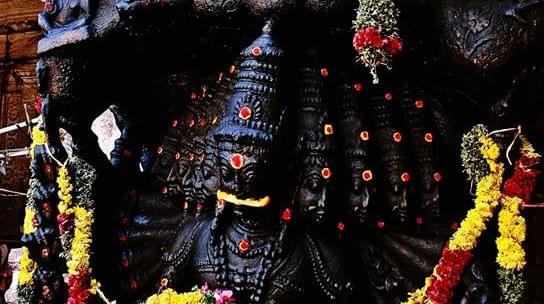
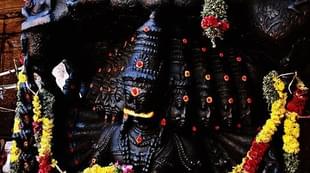
According to a legend we heard, Ravana was flying back on his Pushpaka Vimana to Sri Lanka after having won over a city named Alaka, near Kailasa. Unfortunately for Ravana, Nandi stopped him at Mount Kailasa because the air space over the mountain was declared a no-fly zone in order to prevent any disturbance to the dalliance of Shiva and Parvati. Ravana ridicules Nandi and in return is cursed that monkeys would destroy him.
Even though an arch devotee of Shiva, arrogance gets the better of Ravana and he uproots Mount Kailas with all the might of his twenty arms. As the mountain begins to shake Parvati is frightened and embraces a calm and in-control Shiva who holds her comfortingly and presses the mountain down with the big toe of his right foot trapping Ravana under it. Advised by his ministers Ravana is said to have sung hymns in praise of Shiva for a thousand years aided by a stringed musical instrument created by cutting out his own body parts before Shiva showed mercy and released him.
Sculptures of Shiva showing him sitting with Parvati atop a mountain that is being lifted by Ravana with this twenty arms is called Ravananugraha (Ravana + anugraha) murti. Anugraha means mercy or compassion. These sculptures are also called as “Ravana shaking Mount Kailasa” or “Ravana lifting mount Kailasa”. We have four of such sculptures two from India and one each from Cambodia and Vietnam.
Cave 29 Dumar Lena, Ellora, Maharashtra
Ellora, built by the Rashtrakuta dynasty is an archeological site near the city of Aurangabad in Maharashtra, India. There are 17 Hindu, 12 Buddhist, and 5 Jain caves. The caves are actually structures carved out of the vertical face of the Charanandri hills and are estimated to be from 6th – 12th century A.D. Cave 29 or Dumar Lena is one of the main examples of the Hindu group.
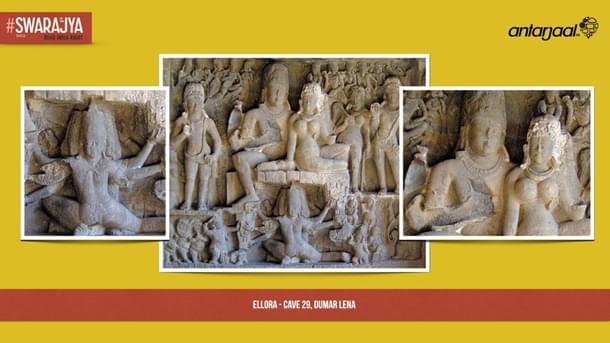
The Dumar Lena consists of an isolated shrine located within a group of halls arranged on a cruciform plan. The halls are adorned with six huge sculptural panels depicting various episodes connected with Lord Siva and one of them is Ravana shaking mount Kailasa.
The sculptor has used more than half of the panel at the top to show Shiva and Parvati seated on mount Kailasa while Ravana trapped under, trying to hold up the mountain with his multiple heads and arms occupies the bottom portion of the panel. Mount Kailasa’s depiction is symbolic at the least, as it looks more like a pedestal than a mountain.
Parvati has a face that seems almost consoled as her right-hand holds onto Shiva’s lap. Shiva is shown sitting with one leg folded and another pressing the ground down. His embrace of Paravati is loving and subtly hints at why the couple should not have been disturbed. “Don’t fear” seems to be what Shiva is telling Parvati with the right hand which though missing is not hard to imagine.
The ten heads of Ravana are created one behind the to other in a circle such that from any angle one will be able to see five heads in front.
Banteay Srei, Cambodia
Banteay Srei, meaning citadel of women or citadel of beauty, is a 10th century Shiva temple built in red sandstone and located near Angkor in Cambodia. Compared to the famous Angkorian constructions these buildings are miniature in size and are widely praised as a “jewel of Khmer art”. It was not built by a king, but by a courtier called Yajnavaraha.
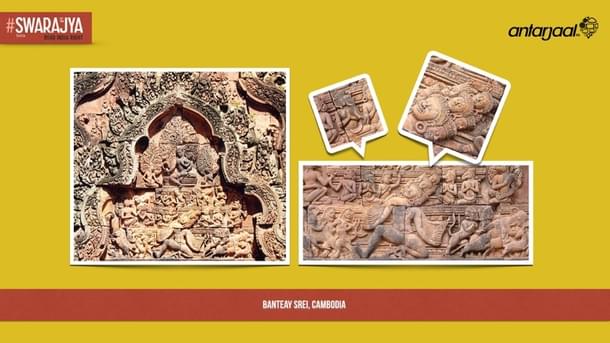
At Banteay Srei, the pediments are relatively large in comparison to the openings. A pediment is a triangular space above a rectangular doorway. An elaborate portrayal of Ravanungraha is found on one of the pediments.
The pediment has a four-tiered depiction of the story. The tiers create a triangular structure giving a beautiful visualization of Mount Kailasa. Ravana with his multiple heads and arms is in the bottom tier while Shiva with Parvati on his lap is in the top-most tier. Shiva like in Ellora is shown sitting with one leg folded while the other is pressing the ground down.
The red sandstone as a material provides for intricate sculpting and the artist has made full use of it by providing elaborate detailing in each tier. The bottom tier has scared animals running away, the second tier has Nandi and Ganesha, the third tier has sages while the top tier has Shiva and Parvati sitting on a pedestal under a tree.
The ten heads of Ravana are created in a pyramid fashion suggesting a 5-4-1 pattern. One can imagine 5 heads over Ravana’s shoulders, 4 more on top of these and one more at the top. In a close up picture, one can easily count the 20 arms of Ravana too.
Pattadakal, Karnataka
Pattadakal is a World Heritage Site famous for Chalukya monuments located in Karnataka. Virupaksha temple is the largest and grandest of all temples in Pattadakal built in 8th Century to commemorate the victory of Vikramaditya II over the Pallavas of Kanchi.
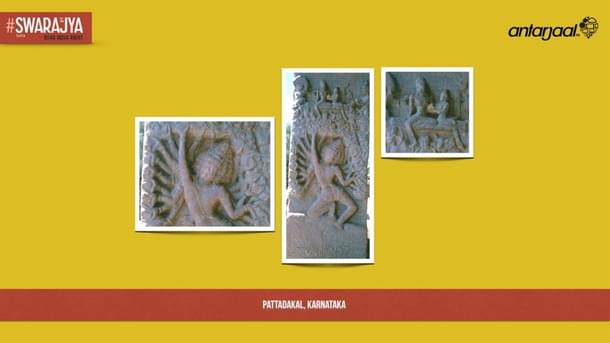
The sculpture here gives more prominence to Ravana, almost three times in size. The yagnopavitam (cross-thread!) is clearly shown and 10 arms of Ravana are clearly depicted on one side. The 10 faces too are depicted one behind the other similar to Ellora.
Shiva is depicted with one folded leg and one pressing the ground down. A terrified Parvati is sitting next to him holding on to his arm. Similar to Ellora the depiction of Mount Kailasa is symbolic.
Mỹ Sơn, Vietnam
Mỹ Sơn is a cluster of abandoned and partially ruined Hindu temples constructed between the 4th and the 14th century AD by the kings of Champa (Chiêm Thành in Vietnamese).
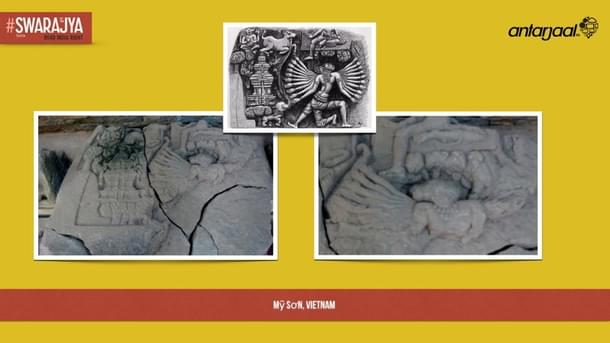
The “poetry in stone” team found a Tympanum depicting the Ravananugraha here. Though most of it is damaged, an imaginary restoration is possible by comparing it with an artist’s impression.
According to Wikipedia, Mỹ Sơn is perhaps the longest inhabited archeological site in Indochina, but a large majority of its architecture was destroyed by US carpet bombing during a single week of the Vietnam War
And below this you will find a bonus! This work is from the Madurai temple, details about which you will soon see in another installment of Poetry In Stone
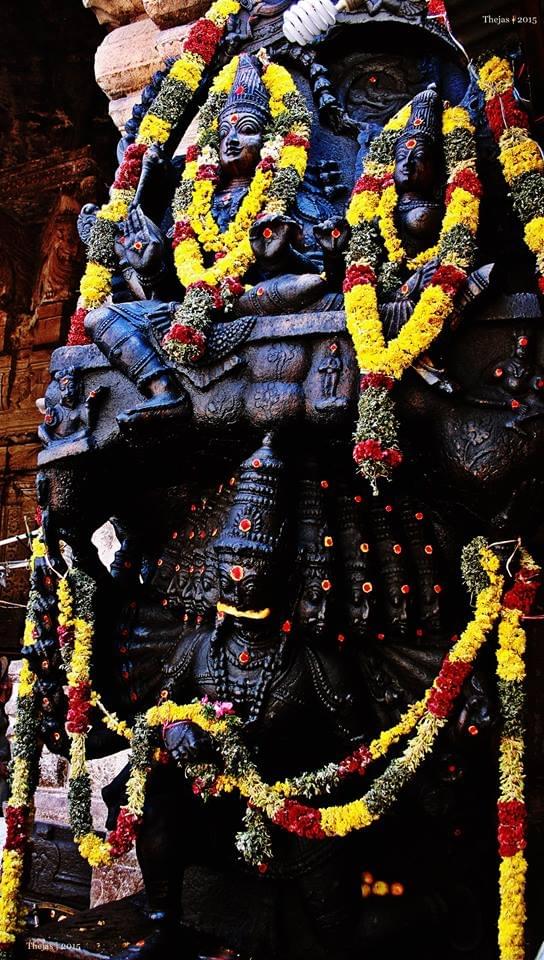
[Image Credit – Thejas]





